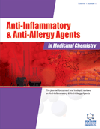- Home
- A-Z Publications
- Anti-Inflammatory & Anti-Allergy Agents in Medicinal Chemistry (Formerly Current Medicinal Chemistry - Anti-Inflammatory and Anti-Allergy Agents)
- Previous Issues
- Volume 7, Issue 3, 2008
Anti-Inflammatory & Anti-Allergy Agents in Medicinal Chemistry (Formerly Current Medicinal Chemistry - Anti-Inflammatory and Anti-Allergy Agents) - Volume 7, Issue 3, 2008
Volume 7, Issue 3, 2008
-
-
Editorial [Inflammation and Atherosclerosis: Recent Insights and Future Perspectives]
More LessAuthors: Manfredi Rizzo, Giovam B. Rini and Kaspar BerneisAtherosclerosis represents a very high-cost disease and its complications are the first cause of death in most of the industrialized countries. Observational and epidemiological data have suggested the potential role of fibrinogen and Creactive protein in coronary artery disease (CAD) development and progression. In addition, the evaluation of markers of infection and inflammation may be of importance for an effectiv Read More
-
-
-
Genetic Polymorphisms of Inflammatory Mediators in Atherosclerosis
More LessIn the vascular wall of large arteries, cellular and humoral immune responses are elicited as a consequence of diverse noxious stimuli within subendothelial space, which further derives in endothelial dysfunction, the accumulation of lipids and formation of the atheromatous plaque. Monocytes, macrophages, T cells, endothelial cells and smooth muscular cells are all players in this inflammatory-atherosclerotic proces Read More
-
-
-
Oxidative Stress, HDL and Atherosclerosis
More LessOxidative stress is a result of an imbalanced equilibrium between reactive oxygen species (ROS) generation and their elimination by antioxidants. There is substantial evidence indicating that exacerbated oxidative stress is relevant for the development of atherosclerosis and its associated complications, especially cardiovascular disease (CVD). According to the oxidative modification hypothesis, oxidised low density lipoprot Read More
-
-
-
Acute Coronary Syndromes: A Role of Immune System
More LessAuthors: Alena Lorenzova and Martin PenickaImmune mechanisms play a role in destabilization of atherosclerotic plaque. Vulnerability of the plaque depends on the features of lipid core, stability of the fibrous cap, macrophage and neutrophil infiltration. Also products of leukocytes like metalloproteinases and myeloperoxidase may destabilize the plaque. Destabilized plaque easily ruptures event after minor impact. After plaque rupture, when myocardial infarction h Read More
-
-
-
Insulin Resistance, Inflammation and Atherosclerosis
More LessAuthors: Jamal Ahmad and Abdur R. KhanType 2 diabetes and obesity are major risk factors for the development of coronary artery disease (CAD), and premature atherosclerosis. Both conditions are associated with insulin resistance, oxidative stress, and inflammation. Several factors that increase the risk of cardiovascular disease tend to cluster together in the same individual. Insulin resistance is believed to be a pathophysiological disturbance that underlies many Read More
-
-
-
Inflammation, Adipocytokines, and Atherosclerosis in the Metabolic Syndrome
More LessBy Ali A. RizviCommunities all over the world are confronted with an alarming rise in the rates of obesity, physical inactivity, and associated metabolic diseases. Central adiposity seems to go hand-in-hand with established risk factors like elevated blood pressure, dyslipidemia, and hyperglycemia. Although genetic and environmental influences modulate the ultimate risk, this clustering of chronic insults to the endothelium takes its toll in the Read More
-
-
-
Periodontitis and Atherosclerosis, a Causal Relationship?
More LessAuthors: Francisco Mesa, Ricardo Munoz, Cristina Godoy and Francisco O'VallePeriodontal and atheromatous diseases affect a large proportion of the general population. They have been associated with each other and may be causally linked. It has not proved possible to confirm a causal relationship between periodontitis and atherosclerosis to date and contradictory results have been published, likely due to the multi-factorial nature of these diseases. The Medline database (PubMed) was explored for Read More
-
-
-
Lipid Lowering Agents, Inflammation and Atherosclerosis
More LessAuthors: Marlena Broncel, Marzena Kozirog and Julita Chojnowska-JezierskaAtherosclerosis has been recognized as an inflammatory disease. The innate and adaptive immunity mechanisms are involved in atherogenesis. Low-grade inflammation is associated with innate immunity activation. The CRP has been proposed as the best indicator of low-grade inflammation and a predictor of cardiovascular events. A triumvirate of targets in the prevention of CVD are: LDL-C aggressive lowering, HDL-C increa Read More
-
-
-
Thiazolidinediones Anti-Inflammatory and Anti-Atherosclerotic Effects in Type 2 Diabetes Mellitus
More LessAuthors: Socrates Pastromas, Dimitris Sakellariou and Spyridon KoulourisAtherosclerosis is a major vascular complication of diabetes and the primary cause of mortality in patients with this disease. Inflammation has been implicated in the pathogenesis, progression and complications of both atherosclerosis and diabetes type 2, and these two complex disorders are often found intertwined in the patients. Peroxisome proliferatoractivated receptors-γ (PPARs-γ) are nuclear receptors that have been inv Read More
-
-
-
Gliclazide, Inflammation and Atherosclerosis
More LessNumerous studies have demonstrated that diabetes associated hyperglycemia creates favourable conditions for overproduction of reactive oxygen species and the development of oxidative stress. Indeed, there is an increase of oxidative stress even at early stages of diabetes in children and adolescents. The results of recent studies suggest that excessive release of superoxide and hydrogen superoxide are responsible for intr Read More
-
-
-
Atherosclerosis and Inflammation: Insight from Carotid and Intracoronary Ultrasound Studies
More LessAuthors: Syed Tahir, Anthony Nappi and Navin K. KapurDating back to the early 1900's, clinical observations have pointed towards an intimate relationship between dyslipidemia, inflammation, and endothelial dysfunction in the pathogenesis of atherosclerosis. Despite a focus on aggressive lowering of low-density lipoprotein cholesterol (LDL-C) in patients at risk for developing cardiovascular disease, only moderate reductions in cardiovascular events have been achieved, sugges Read More
-
Volumes & issues
-
Volume 24 (2025)
-
Volume 23 (2024)
-
Volume 22 (2023)
-
Volume 21 (2022)
-
Volume 20 (2021)
-
Volume 19 (2020)
-
Volume 18 (2019)
-
Volume 17 (2018)
-
Volume 16 (2017)
-
Volume 15 (2016)
-
Volume 14 (2015)
-
Volume 13 (2014)
-
Volume 12 (2013)
-
Volume 11 (2012)
-
Volume 10 (2011)
-
Volume 9 (2010)
-
Volume 8 (2009)
-
Volume 7 (2008)
-
Volume 6 (2007)
-
Volume 5 (2006)
Most Read This Month
Article
content/journals/aiaamc
Journal
10
5
false
en


